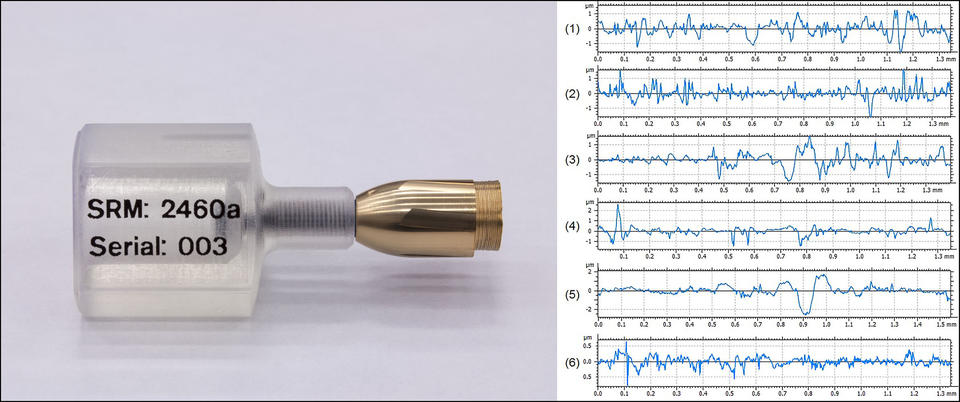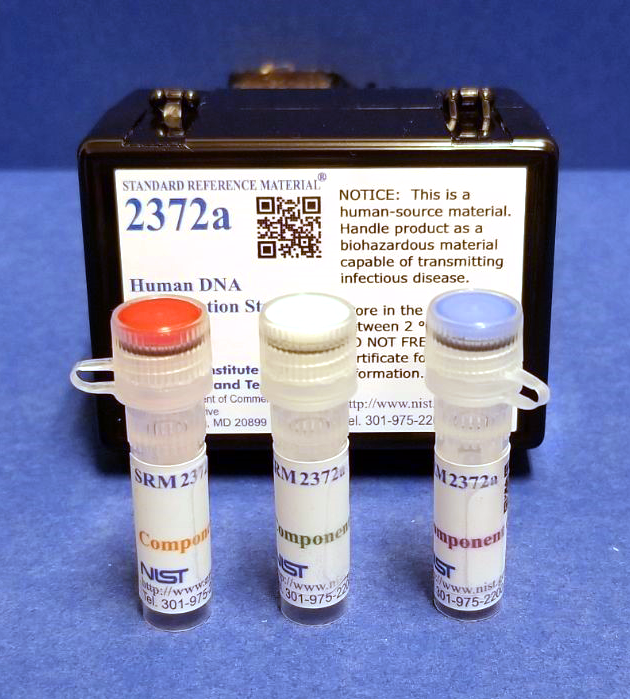NIST Updates Forensic Standard Reference Materials
New standard bullet, human DNA standard enable accurate measurements in forensic science labs.
At forensic science labs, analysts literally weigh the evidence. They also measure it in other ways. They use microscopes, DNA profiling kits, chemical analyzers and other instruments, all of which must be calibrated to ensure accurate measurements. And in forensic labs, where those measurements might be used to determine a person’s guilt or innocence, accuracy is particularly important.
To help ensure accuracy, NIST manufactures physical standards that are used to calibrate analytical instruments in much the same way that a precisely manufactured kilogram mass can be used to calibrate a scale. These standard reference materials, or SRMs, as they are called, take many forms.
NIST recently released updated versions of two forensic SRMs—the standard bullet and the human DNA quantitation standard. Here’s a quick rundown on each.
SRM 2460a: The Standard Bullet
The NIST standard bullet isn’t a real bullet, but it looks like a typical 9mm bullet that has been fired from a gun. A series of six parallel markings appear on its surface, and if you turn it under a light, you can see that those markings are made up of fine striations, which are reproduced precisely on each standard bullet, down to the microscopic level.

Those striations are meant to simulate the impressions that a gun leaves, like a ballistic signature, on every bullet it fires. For instance, if investigators recover a bullet from a crime scene, they can test-fire a suspect’s weapon to produce a second bullet, then compare the ballistic signatures to see if the two bullets might have been fired from the same gun.
In many forensic firearms labs, examiners compare bullets visually under a split-screen microscope. But at state-of-the-art laboratories, they use scanning optical microscopes that measure the 3D features on a bullet’s surface, including the microscopic detail within the striations. This provides greater detail and accuracy than a 2D comparison.
A firearms examiner can test whether their 3D surface scanning microscope is properly calibrated by measuring the striations on the NIST standard bullet. They then compare those measurements with data provided by NIST. If their measurements are off, they know that something is amiss.
Many labs perform these tests regularly for quality control. “This is one way to catch problems quickly,” said NIST physical scientist Thomas Brian Renegar, who led the standard bullet project. “That way you can diagnose and fix the problem before doing additional casework.”
The prior version of the standard bullet, which was manufactured using a diamond-turning process that engraved the striations onto the bullet, cost more than $2,000 each. With funding from the National Institute of Justice, Renegar developed a new manufacturing method that involves casting polyurethane copies in a mold, then plating them with nickel and gold. This new method allows NIST to sell the standard bullet for $350.
SRM 2372a: The Human DNA Quantitation Standard
This SRM comprises three vials, each containing human DNA suspended in a clear solution. The first vial contains DNA from a male, the second from a female, and the third contains both female and male DNA in a three-to-one ratio.

Forensic analysts use this SRM when generating a genetic fingerprint, also called a DNA profile, of a suspect. If blood or other biological evidence is found at a crime scene, the analyst extracts DNA from the evidence, then processes it to generate the profile.
For this to work properly, the analyst needs to know how much DNA is in the extract before they process it. “Put in too little, and you might end up with an incomplete DNA profile,” said Erica Romsos, the research scientist at NIST who managed production of this standard. “Put in too much, and you can blow out the signal, making the results difficult to interpret.”
The three vials in this standard contain precisely measured quantities of human DNA, which forensic analysts use to calibrate their instruments when measuring how much DNA they extracted from the evidence. This helps ensure that they process the right amount of DNA when generating the profile.
In the new version of this standard, the quantity of DNA in each of the vials was measured using an advanced technique called digital PCR. This gives a more precise measurement than was possible in the prior version and allows for more accurate calibrations in the lab. In addition, the prior version only listed quantities for the type of DNA that is found in the nucleus of the cell. The new version also lists the quantity of mitochondrial DNA, which is found outside the nucleus and can be useful when working with evidence that contains damaged or degraded DNA.
Other Forensic SRMs
These are just two of the forensic SRMs that NIST manufactures. NIST also produces other standards used in ballistics and DNA labs, as well as alcohol solutions used to calibrate breathalyzers, ignitable liquids used in arson investigations and more. Although the types of forensic SRMs vary, they are all manufactured with the same goal in mind: to help ensure the reliability of the scientific evidence used in criminal investigations.

